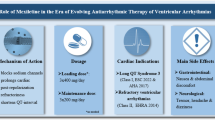Abstract
Gene therapy-based modulation of atrioventricular (AV) conduction by overexpression of a constitutively active inhibitory Gα i protein effectively reduced heart rates in atrial fibrillation (AF). However, catecholamine stimulation caused an excessive increase in ventricular rate. We hypothesized that modest genetic suppression of a stimulatory G protein in the AV node would allow persistent rate control in acute AF and would prevent undesired heart rate acceleration during β-adrenergic activation. Atrial fibrillation was induced in 12 pigs by atrial burst pacing via an implanted cardiac pacemaker. Study animals were then assigned to receive either Ad-siRNA-Gαs gene therapy to inactivate Gαs protein or Ad-β-gal as control. Gαs protein inactivation resulted in a 20 % heart rate reduction (P < 0.01). AH and HV intervals were prolonged by 37 ms (P < 0.001) and 28 ms (P < 0.001), respectively, demonstrating atrioventricular conduction delay. Impairment of left ventricular ejection fraction (LVEF) during AF was attenuated by Gαs suppression (LVEF 49 %) compared with controls (LVEF 34 %; P = 0.03). Isoproterenol application accelerated ventricular heart rate from 233 to 281 bpm (P < 0.001) in control animals but did not significantly affect pigs treated with Ad-siRNA-Gαs (192 vs. 216 bpm; P = 0.19). In conclusion, genetic inhibition of Gαs protein in the AV node reduced heart rate and prevented AF-associated reduction of cardiac function in a porcine model. Rate control by gene therapy may provide an alternative to current pharmacological treatment of AF.









Similar content being viewed by others
References
Bauer A, McDonald AD, Donahue JK (2004) Pathophysiological findings in a model of persistent atrial fibrillation and severe congestive heart failure. Cardiovasc Res 61:764–770. doi:10.1016/j.cardiores.2003.12.013
Bauer A, McDonald AD, Nasir K, Peller L, Rade JJ, Miller JM, Heldman AW, Donahue JK (2004) Inhibitory G protein overexpression provides physiologically relevant heart rate control in persistent atrial fibrillation. Circulation 110:3115–3120. doi:10.1161/01.CIR.0000147185.31974.BE
Bhuiyan ZA, van den Berg MP, van Tintelen JP, Bink-Boelkens MT, Wiesfeld AC, Alders M, Postma AV, van Langen I, Mannens MM, Wilde AA (2007) Expanding spectrum of human RYR2-related disease: new electrocardiographic, structural, and genetic features. Circulation 116:1569–1576. doi:10.1161/CIRCULATIONAHA.107.711606
Bikou O, Thomas D, Trappe K, Lugenbiel P, Kelemen K, Koch M, Soucek R, Voss F, Becker R, Katus HA, Bauer A (2011) Connexin 43 gene therapy prevents persistent atrial fibrillation in a porcine model. Cardiovasc Res 92:218–225. doi:10.1093/cvr/CVR209
Burstein B, Nattel S (2008) Atrial fibrosis: mechanisms and clinical relevance in atrial fibrillation. J Am Coll Cardiol 51:802–809. doi:10.1016/j.jacc.2007.09.064
Chen WJ, Yeh YH, Lin KH, Chang GJ, Kuo CT (2011) Molecular characterization of thyroid hormone-inhibited atrial L-type calcium channel expression: implication for atrial fibrillation in hyperthyroidism. Basic Res Cardiol 106:163–174. doi:10.1007/s00395-010-0149-5
Cho HC, Marban E (2010) Biological therapies for cardiac arrhythmias: can genes and cells replace drugs and devices? Circ Res 106:674–685. doi:10.1161/CIRCRESAHA.109.212936
Deedwania PC, Lardizabal JA (2010) Atrial fibrillation in heart failure: a comprehensive review. Am J Med 123:198–204. doi:10.1016/j.amjmed.2009.06.033
Donahue JK, Heldman AW, Fraser H, McDonald AD, Miller JM, Rade JJ, Eschenhagen T, Marban E (2000) Focal modification of electrical conduction in the heart by viral gene transfer. Nat Med 6:1395–1398. doi:10.1038/82214
Du J, Xie J, Zhang Z, Tsujikawa H, Fusco D, Silverman D, Liang B, Yue L (2010) TRPM7-mediated Ca2+ signals confer fibrogenesis in human atrial fibrillation. Circ Res 106:992–1003. doi:10.1161/CIRCRESAHA.109.206771
Fabritz L, Kirchhof P, Fortmüller L, Auchampach JA, Baba HA, Breithardt G, Neumann J, Boknik P, Schmitz W (2004) Gene dose-dependent atrial arrhythmias, heart block, and brady-cardiomyopathy in mice overexpressing A3 adenosine receptors. Cardiovasc Res 62:500–508. doi:10.1016/j.cardiores.2004.02.004
Go AS, Hylek EM, Phillips KA, Chang Y, Henault LE, Selby JV, Singer DE (2001) Prevalence of diagnosed atrial fibrillation in adults: national implications for rhythm management and stroke prevention: the AnTicoagulation and Risk Factors in Atrial Fibrillation (ATRIA) Study. JAMA 285:2370–2375. doi:10.1001/jama.285.18.2370
Goonasekera SA, Hammer K, Auger-Messier M, Bodi I, Chen X, Zhang H, Reiken S, Elrod JW, Correll RN, York AJ, Sargent MA, Hofmann F, Moosmang S, Marks AR, Houser SR, Bers DM, Molkentin JD (2012) Decreased cardiac L-type Ca2+ channel activity induces hypertrophy and heart failure in mice. J Clin Invest 122:280–290. doi:10.1172/JCI58227
Groenveld HF, Crijns HJ, Van den Berg MP, Van Sonderen E, Alings AM, Tijssen JG, Hillege HL, Tuininga YS, Van Veldhuisen DJ, Ranchor AV, Van Gelder IC, RACEII Investigators (2011) The effect of rate control on quality of life in patients with permanent atrial fibrillation: data from the RACE II (Rate Control Efficacy in Permanent Atrial Fibrillation II) study. J Am Coll Cardiol 58:1795–1803. doi:10.1016/j.jacc.2011.06.055
Heinzel FR, Luo Y, Li X, Boengler K, Buechert A, García-Dorado D, Di Lisa F, Schulz R, Heusch G (2005) Impairment of diazoxide-induced formation of reactive oxygen species and loss of cardioprotection in connexin 43 deficient mice. Circ Res 97:583–586. doi:10.1161/01.RES.0000181171.65293.65
Heusch G (2010) Adenosine and maximum coronary vasodilation in humans: myth and misconceptions in the assessment of coronary reserve. Basic Res Cardiol 105:1–5. doi:10.1007/s00395-009-0074-7
Khand AU, Rankin AC, Kaye GC, Cleland JG (2000) Systematic review of the management of atrial fibrillation in patients with heart failure. Eur Heart J 21:614–632. doi:10.1053/euhj.1999.1767
Hurtado C, Wigle JT, Dibrov E, Maddaford TG, Pierce GN (2007) A comparison of adenovirally delivered molecular methods to inhibit Na+/Ca2+exchange. J Mol Cell Cardiol 43:49–53. doi:10.1016/j.yjmcc.2007.04.011
Kirchhof P, Fabritz L, Fortmuller L, Matherne GP, Lankford A, Baba HA, Schmitz W, Breithardt G, Neumann J, Boknik P (2003) Altered sinus nodal and atrioventricular nodal function in freely moving mice overexpressing the A1 adenosine receptor. Am J Physiol Heart Circ Physiol 285:H145–H153. doi:10.1152/ajpheart.01036.2002
Kovesdi I, Brough DE, Bruder JT, Wickham TJ (1997) Adenoviral vectors for gene transfer. Curr Opin Biotechnol 8:583–589. doi:10.1016/S0958-1669(97)80033-X
Mangoni ME, Couette B, Bourinet E, Platzer J, Reimer D, Striessnig J, Nargeot J (2003) Functional role of L-type Cav1.3 Ca2+ channels in cardiac pacemaker activity. Proc Natl Acad Sci USA 100:5543–5548. doi:10.1073/pnas.0935295100
Mustafa SJ, Morrison RR, Teng B, Pelleg A (2009) Adenosine receptors and the heart: role in regulation of coronary blood flow and cardiac electrophysiology. Handb Exp Pharmacol 193:161–188. doi:10.1007/978-3-540-89615-9_6
Nishida K, Maguy A, Sakabe M, Comtois P, Inoue H, Nattel S (2011) The role of pulmonary veins vs. autonomic ganglia in different experimental substrates of canine atrial fibrillation. Cardiovasc Res 89:825–833. doi:10.1093/cvr/cvq332
Salazar NC, Chen J, Rockman HA (2007) Cardiac GPCRs: GPCR signaling in healthy and failing hearts. Biochim Biophys Acta 1768:1006–1018. doi:10.1016/j.bbamem.2007.02.010
Schmidt C, Kisselbach J, Schweizer PA, Katus HA, Thomas D (2011) The pathology and treatment of cardiac arrhythmias: Focus on atrial fibrillation. Vasc Health Risk Manag 7:193–202. doi:10.2147/VHRM.S10758
Sheng XY, Qu Y, Dan P, Lin E, Korthout L, Bradford A, Hove-Madsen L, Sanatani S, Tibbits GF (2011) Isolation and characterization of atrioventricular nodal cells from neonate rabbit heart. Circ Arrhythm Electrophysiol 4:936–946. doi:10.1161/CIRCEP.111.964056
Shi Y, Ducharme A, Li D, Gaspo R, Nattel S, Tardif JC (2001) Remodeling of atrial dimensions and emptying function in canine models of atrial fibrillation. Cardiovasc Res 52:217–225. doi:10.1016/S0008-6363(01)00377-7
Soucek R, Thomas D, Kelemen K, Bikou O, Seyler C, Voss F, Becker R, Koenen M, Katus HA, Bauer A (2012) Genetic suppression of atrial fibrillation using a dominant-negative ether-a-go-go-related gene mutant. Heart Rhythm 9:265–272. doi:10.1016/j.hrthm.2011.09.008
Suenari K, Chen YC, Kao YH, Cheng CC, Lin YK, Chen YJ, Chen SA (2011) Discrepant electrophysiological characteristics and calcium homeostasis of left atrial anterior and posterior myocytes. Basic Res Cardiol 106:65–74. doi:10.1007/s00395-010-0132-1
Trappe K, Thomas D, Bikou O, Kelemen K, Lugenbiel P, Voss F, Becker R, Katus HA, Bauer A (2011) Suppression of persistent atrial fibrillation by genetic knockdown of caspase 3: a pre-clinical pilot study. Eur Heart J. doi:10.1093/eurheartj/ehr269
Van Gelder IC, Groenveld HF, Crijns HJ, Tuininga YS, Tijssen JG, Alings AM, Hillege HL, Bergsma-Kadijk JA, Cornel JH, Kamp O, Tukkie R, Bosker HA, Van Veldhuisen DJ, Van den Berg MP, RACEII Investigators (2010) Lenient versus strict rate control in patients with atrial fibrillation. N Engl J Med 362:1363–1373. doi:10.1056/NEJMoa1001337
Xiong W, Tian Y, DiSilvestre D, Tomaselli GF (2005) Transmural heterogeneity of Na+–Ca2+ exchange: evidence for differential expression in normal and failing hearts. Circ Res 97:207–209. doi:10.1161/01.RES.0000175935.08283.27
Yang SS, Han W, Cao Y, Dong G, Zhou G, Li WM, Gan RT, Chang HY, Wang Z (2011) Effects of high thoracic epidural anesthesia on atrial electrophysiological characteristics and sympathetic nerve sprouting in a canine model of atrial fibrillation. Basic Res Cardiol 106:495–506. doi:10.1007/s00395-011-0154-3
Yuill KH, Hancox JC (2002) Characteristics of single cells isolated from the atrioventricular node of the adult guinea-pig heart. Pflugers Arch 445:311–320. doi:10.1007/s00424-002-0932-8
Acknowledgments
We thank Jennifer Gütermann, Sina Huntscha, and Bianca Menrath for excellent technical assistance and Muhammed Kashif (Department of Medicine I and Clinical Chemistry, University of Heidelberg) for help with histological quantification of fibrosis. This study was supported in part by grants from the Deutsche Forschungsgemeinschaft and from Medtronic (to A.B.), from the University of Heidelberg and the Deutsche Forschungsgemeinschaft (FRONTIERS program to D.T.), from the ADUMED foundation (to D.T.), from the German Heart Foundation/German Foundation of Heart Research (project F/06/10 to D.T.) and from the Max-Planck-Society (TANDEM project to P.A.S.). Pacemakers, leads, and burst pacing software were kindly provided by Medtronic.
Author information
Authors and Affiliations
Corresponding author
Additional information
P. Lugenbiel and D. Thomas contributed equally to this work.
Rights and permissions
About this article
Cite this article
Lugenbiel, P., Thomas, D., Kelemen, K. et al. Genetic suppression of Gαs protein provides rate control in atrial fibrillation. Basic Res Cardiol 107, 265 (2012). https://doi.org/10.1007/s00395-012-0265-5
Received:
Revised:
Accepted:
Published:
DOI: https://doi.org/10.1007/s00395-012-0265-5




